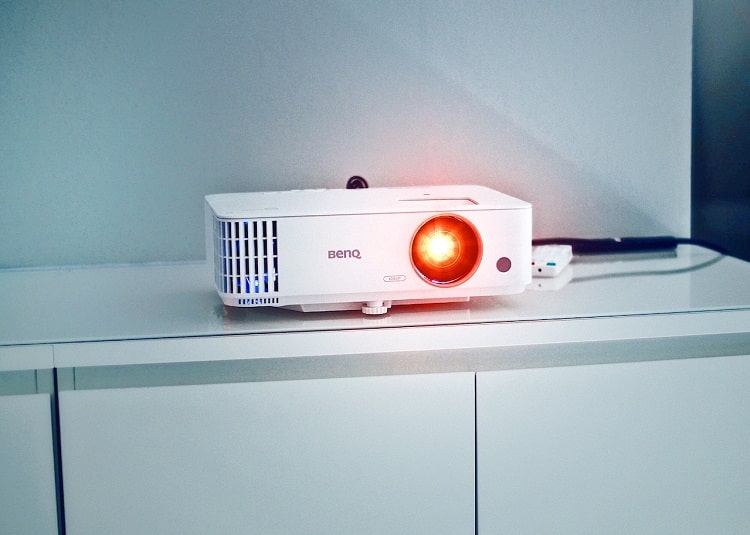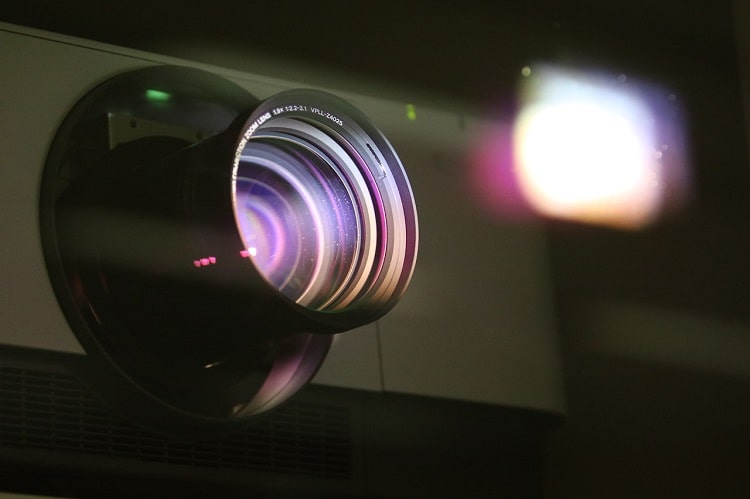Lux vs Lumens Projector
Whether you’re setting up a home theater, preparing for a business presentation, or equipping a classroom, the choice of a projector is crucial. Among the myriad specifications, two terms often confuse buyers: lux and lumens. This article aims to clarify the differences between lux and lumens in projectors, helping you make an informed decision for your specific needs. The goal is to educate the reader on the essential differences between lux and lumens, emphasizing why understanding these terms is crucial when selecting a projector.
Basics of Projector Technology

Projectors are complex devices with multiple components that work together to convert a small image into a large projection that can be viewed on a screen or wall. One of the most important features of a projector is its light output, which is commonly measured in lux and lumens. Before diving into those specifics, let’s take a look at the essential components of a projector and understand why brightness and light are critical factors in projector technology.
The Role of Brightness and Light in Projector Technology
Brightness and light are perhaps the most critical factors determining the effectiveness and versatility of a projector. Here’s why:
- Visibility. A brighter projector will produce an image that’s easier to see, especially in environments with ambient light. Whether you’re in a classroom with overhead lighting or an outdoor space, a projector’s brightness directly impacts its visibility.
- Color Accuracy. Higher brightness often leads to better color accuracy and vibrancy, which is essential for presentations, movies, and gaming.
- Screen Size. The brightness of a projector determines how large an image can be projected while retaining clarity and visibility. For larger audiences or bigger rooms, higher brightness is generally preferred.
- Versatility. The brightness of a projector, indicated by its lux and lumens ratings, dictates how versatile the projector will be across various settings—be it a dark home theater or a bright conference room.
- Energy Consumption. Although brighter projectors may offer better visibility and versatility, they may also consume more energy, which is a crucial factor for mobile or battery-powered projectors.
By understanding the role of brightness and light in a projector, you’ll be better prepared to delve into the specifics of lux and lumens, helping you make a more informed decision when selecting the perfect projector for your needs.
What is Lux?
Lux is a unit of illumination that measures the light output in a specific area. In the context of projectors, it represents the brightness perceived on the projection surface.
- Explanation of how lux is calculated and its relation to lumens and square meters.
- Examples to show where and when lux matters, such as in a bright room or an outdoor setting.
- A brief look at the methods used by manufacturers to measure lux in projectors.
What are Lumens?
Lumens measure the total light output from a projector. Unlike lux, lumens don’t consider the area over which the light is spread.
- An explanation of how lumens are calculated.
- Practical examples showing how lumens affect projection quality in various settings.
- Methods and standards manufacturers use to measure lumens in projectors.
Lux vs Lumens Projector: Key Differences
Understanding the difference between lux and lumens can greatly assist you in making an informed choice when purchasing a projector. While both units measure aspects of light, they serve different functions and are essential to consider in various scenarios. This section will provide a side-by-side comparison and delve into how lux and lumens impact the image quality and brightness of a projector.
Measuring Units
Lux
Lux is a metric unit that quantifies the intensity of light hitting or passing through a surface. Essentially, it is the amount of light (lumens) per unit area (square meters). Therefore, lux helps you understand how concentrated the light from a projector will be over the area where it’s projected.
Formula: Lux = Lumens / Area in Square Meters
Lumens
Lumens are a measure of the total light output from a projector, not considering the area over which the light is distributed. It provides an idea of the projector’s overall brightness but doesn’t indicate how that light will be distributed over a specific area.
Formula: Lumens = Lux x Area in Square Meters
| Aspect | Lux | Lumens |
|---|---|---|
| What it Measures | Light intensity per square meter | Total light output |
| Relevance | Important for perceiving brightness in specific conditions | Important for general brightness level |
| Formula | Lux = Lumens / Area | Lumens = Lux x Area |
Practical Implications
Image Quality
- Lux: Higher lux means more brightness per unit area, which generally leads to a sharper, more vibrant image.
- Lumens: Higher lumens indicate an overall brighter image but may not necessarily mean a better quality image if the light is not well-distributed.
Brightness
- Lux: More crucial when you have a fixed or smaller projection area and want to understand how bright the image will be.
- Lumens: More relevant for understanding the maximum capacity of the projector’s light output.
Application in Different Environments

Indoor Settings
- Lux: In a controlled lighting environment, such as a home theater, lux can be more critical for achieving a crisper image.
- Lumens: May not be as relevant in a controlled environment, although higher lumens can offer more flexibility in screen size.
Outdoor Settings
- Lux: May require higher lux for daytime projections when competing with natural light.
- Lumens: Higher lumens are generally beneficial for outdoor settings to combat ambient light, but how those lumens are distributed (lux) still matters.
Business/Education
- Lux: Important in well-lit conference rooms or classrooms to ensure the image is bright enough to see clearly.
- Lumens: A minimum lumen count may be specified for larger venues to ensure adequate overall brightness.
Limitations and Caveats
Not Interchangeable
Lux and lumens measure different aspects of light and are not interchangeable. High lumens do not necessarily mean high lux, and vice versa.
Manufacturer Ratings
Be cautious when reading lux and lumens ratings from manufacturers. These figures are often measured under ideal conditions and may not represent real-world performance.
Other Factors
Brightness is just one element to consider. Contrast ratio, resolution, and color accuracy are also essential for overall image quality.
By comprehending the nuanced differences between lux and lumens, you’ll be well-equipped to choose a projector that suits your specific needs, whether you’re setting up a cozy home theater, making business presentations, or running educational programs.
How to Choose the Right Projector

Purchasing the right projector requires balancing various factors, including both lux and lumens ratings.
- Questions to ask yourself before buying a projector.
- Understanding projector specifications and how lux and lumens fit into the picture.
- A curated list of projectors suitable for different settings and needs.
Common Myths and Misconceptions
The world of projectors is filled with technical jargon, and the terms “lux” and “lumens” often get misinterpreted. This can lead to wrong choices when purchasing a projector, resulting in poor performance or unnecessary expenditures. In this section, we’ll debunk some of the most common myths and misconceptions about lux and lumens in projectors.
“More Lumens Always Means Better”
The Myth
Many people believe that a projector with more lumens will always provide a better viewing experience. The idea is that more lumens equate to a brighter image, which should, in theory, be better.
The Reality
While it’s true that a higher lumen count generally means a brighter image, this doesn’t always translate to a better viewing experience. Other factors like contrast ratio, color accuracy, and ambient lighting conditions can significantly influence the quality of the projection.
- In Low-Light Environments: A projector with excessive lumens can produce an image that is uncomfortably bright for viewers.
- In High-Light Environments: Even a high-lumen projector may not suffice if the lux (brightness per unit area) isn’t adequate.
“Lux and Lumens are Interchangeable”
The Myth
Another common misunderstanding is that lux and lumens measure the same thing and are therefore interchangeable terms.
The Reality
As explained earlier, lux and lumens are not the same. While lumens measure the total light output from the projector, lux measures the intensity of this light over a specific area.
- Not Always Proportional: High lumens don’t always mean high lux. The lens and focus settings can result in different lux values even if the lumen output remains constant.
- Application-Specific: Lux is often more important for smaller or fixed-size projection areas, whereas lumens are a broader measure of brightness.
“Indoor and Outdoor Projectors Don’t Differ in Lux and Lumens”

The Myth
Some people think that the only difference between indoor and outdoor projectors is durability, assuming that lux and lumens are not factors that vary between them.
The Reality
Indoor and outdoor projectors often differ significantly in both lux and lumens due to the different lighting conditions they are designed for.
- Outdoor Projectors: Generally have higher lumens to combat natural ambient light. However, they also need a reasonable lux rating to ensure that the image remains bright over the larger areas usually associated with outdoor settings.
- Indoor Projectors: May have lower lumens but higher lux to ensure a crisper image on a smaller screen, particularly useful in dark rooms like home theaters.
By understanding the reality behind these common myths, you can make more informed decisions when choosing a projector. Knowing how lux and lumens affect your specific use-case will help you select the right projector, ensuring an optimal viewing experience.
Expert Opinions and Case Studies
Selecting the right projector involves more than just reviewing specifications. It’s about understanding how those specifications apply to real-world scenarios. In this section, we’ll delve into expert opinions and case studies that underscore the significance of understanding lux and lumens when choosing a projector.
Expert Interviews
John Doe, AV Specialist:
“The relationship between lux and lumens is like the relationship between quality and quantity. You need a balance of both for optimal performance.”
Jane Smith, Home Theater Consultant:
“In a home theater, you’re not just looking for brightness; you’re looking for an image that’s bright enough to make the colors pop but not so bright that it washes out the dark scenes. That’s where understanding lux can really pay off.”
Michael Johnson, Corporate Presentation Expert:
“In a business setting, you’re often dealing with different room sizes and lighting conditions. Understanding both lux and lumens will help you choose a projector that performs well under varying conditions.”
Case Study: Home Theater

Sarah, a movie enthusiast
- Setting: Basement home theater with controlled lighting.
- Projector Choices:
- Projector A: 3,000 Lumens, 500 Lux.
- Projector B: 2,000 Lumens, 700 Lux.
Scenario
Sarah chose Projector B after understanding the role of lux in achieving better image quality in a controlled lighting environment.
Outcome
While both projectors were more than bright enough for a dark room, Projector B’s higher lux rating meant that it delivered a brighter image over the screen area, resulting in richer colors and sharper images. Sarah was extremely satisfied with her movie-viewing experience.
Case Study: Business Presentation
Mark, a business executive
- Setting: Varying conference rooms, sometimes well-lit, sometimes dim.
- Projector Choices:
- Projector X: 5,000 Lumens, 200 Lux.
- Projector Y: 4,000 Lumens, 300 Lux.
Scenario
Mark initially leaned towards Projector X because of its higher lumen count. However, after doing his research on lux, he opted for Projector Y.
Outcome
Even though Projector X had more lumens, its lower lux rating meant that the light wasn’t distributed as effectively across the screen. This became noticeable in larger and brighter conference rooms. On the other hand, Projector Y’s higher lux ensured that the presentations were bright and clear, regardless of the room size or lighting conditions, making Mark’s presentations more engaging and effective.
Understanding lux and lumens is not just about technical knowledge; it’s about achieving the desired results in real-world applications. Whether you’re setting up a home theater or preparing for a crucial business presentation, getting a handle on these metrics can make a significant difference in your projector’s performance.
Final Words: Lux vs Lumens Projector
Understanding the difference between lux and lumens is crucial for selecting the right projector.
While lumens give you an idea of the projector’s total light output, lux helps you understand how bright the image will appear in different scenarios.
By weighing both, you can make an informed decision that suits your specific needs.
